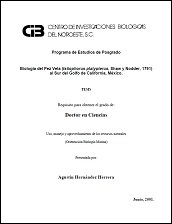Expresión génica diferencial de tres fenotipos de vidrillo (Mesembryanthemum crystallinum) en respuesta a estrés por NaCl
Abstract
"Con la finalidad de identificar genes que se encuentran aumentando y reprimiendo sus
niveles de expresión en respuesta a estrés por NaCl en vidrillo, utilizamos la metodología
de microarreglos heterólogos, donde el nivel de expresión de 30,000 cDNA independientes
de Arabidopsis thaliana fueron utilizados para medir por hibridación con ARN extraído
individualmente de los fenotipos P0, P9 y P11 de vidrillo. Logramos identificar que en el
fenotipo P0: 1893 genes fueron sobre-expresados (6.315%), en el fenotipo P9: 1999 genes
(6.66%), mientras que para el fenotipo P11 solo el 4.61% de los genes fue sobre-expresado
(1383 genes). En cuanto al número de genes reprimidos en los fenotipos P0, P9 y P11
identificamos, respectivamente; 1218, 844 y 1594 genes regulados de manera negativa.
Algunos de estos genes regulados diferencialmente, ya sea positiva o negativamente, son
expresados de manera única en cada fenotipo. Un análisis informático mostró que existen
diferencias en algunas rutas metabólicas de interés como por ejemplo, en el metabolismo de
aminoácidos solo los fenotipos de P0 y P9 aumentan el nivel de expresión de genes
relacionados con el metabolismo de arginina y prolina, cuya acumulación en la planta esta
relacionada con la tolerancia de la misma ante un estrés, por otro lado el fenotipo P11
disminuye los niveles de expresión de genes involucrados en dicha ruta; además entre los
genes donde se esta dando un aumento en los niveles de expresión en esta ruta,
encontramos genes relacionados con el metabolismo de poliaminas como la putrescina,
espermidina y la espermina, cuya acumulación en la planta tiene efectos positivos en la
tolerancia a diversos tipos de estrés. Por otro lado tenemos que, solo el fenotipo P11
aumenta los niveles de expresión de genes relacionados con el metabolismo de la trehalosa,
un disacárido importante en la tolerancia al estrés. También se identificaron cambios en la
respuesta a estrés oxidativo y en peroxisomas, donde el fenotipo P9 es quien mejor
respuesta tiene..." "With the objective of identifying genes that are increasing and suppressing expression
levels in vidrillo’s salt stress resistance response, we used heterologous microarray
methodology, where the independent cDNA expression level of 30,000 from Arabidopsis
thaliana was used to measure RNA hybridization extracted individually from P0, P9, and
P11 vidrillo phenotypes. We identified that 1893 P0 phenotype genes were over-expressed
(6.315%); 1999 P9 phenotype genes (6.66%); while only 4.61% of P11 phenotype genes
were over-expressed (1383). As for the number of repressed genes in P0, P9, and P11
phenotypes identified, we found 1218, 844, and 1594 negatively regulated genes,
respectively. Some of the differentially regulated genes, either positively or negatively, are
expressed uniquely in each phenotype. The computational analysis showed some
differences in metabolic pathways of interest; for example, in amino acid metabolism only
P0 and P9 phenotypes were able to increase the expression level of genes related to
arginine and proline metabolism, whose accumulation in the plant is related to abiotic stress
resistance. On the other hand, P11 phenotype decreased expression levels of the genes
involved in the same pathway. Also, in this metabolic route where genes were found to
increase their expression levels, we found those related to polyamine resistance such as
putrescine, spermidine, and spermine, whose accumulation in the plant have positive effects
on tolerance to various stress types. Another thing was that only phenotype P11 increased
the expression levels of genes related to the metabolism of trehalose, an important
disaccharide in stress tolerance. We could identify changes in oxidative stress response in
peroxisomes, where P9 phenotype had the best response. It was possible to identify changes
in expression levels of the genes involved in osmotic and salt stress and ion transport
responses, where P0 and P9 phenotypes were those having an apparent best response.
Finally we quantified the relative expression of the antiporter genes McNHx3 and McNHaD
by qPCR; the results showed that only P0 and P9 phenotypes could overexpress these
genes, while P11 phenotype had them suppressed. Thus at least to that reported so far, P11
phenotype does not have a mechanism for Na+ ion compartmentalization as P0 and P9 do;
however, P11 phenotype continues to tolerate NaCl stress to a lesser extent, though."
Collections
Related items
Showing items related by title, author, creator and subject.
-
PROMOCIÓN DEL PERIFITON PARA EL CULTIVO DE CAMARÓN BLANCO: HACIA UNA ACUICULTURA ECOLÓGICA
DOMENICO VOLTOLINA LOBINA; JUAN MANUEL AUDELO NARANJO; MARIA DEL ROSARIO PACHECO MARGES -
Suelo y Erosión
YOLANDA LOURDES MAYA DELGADO


